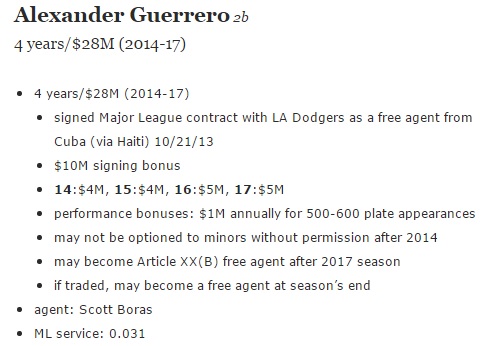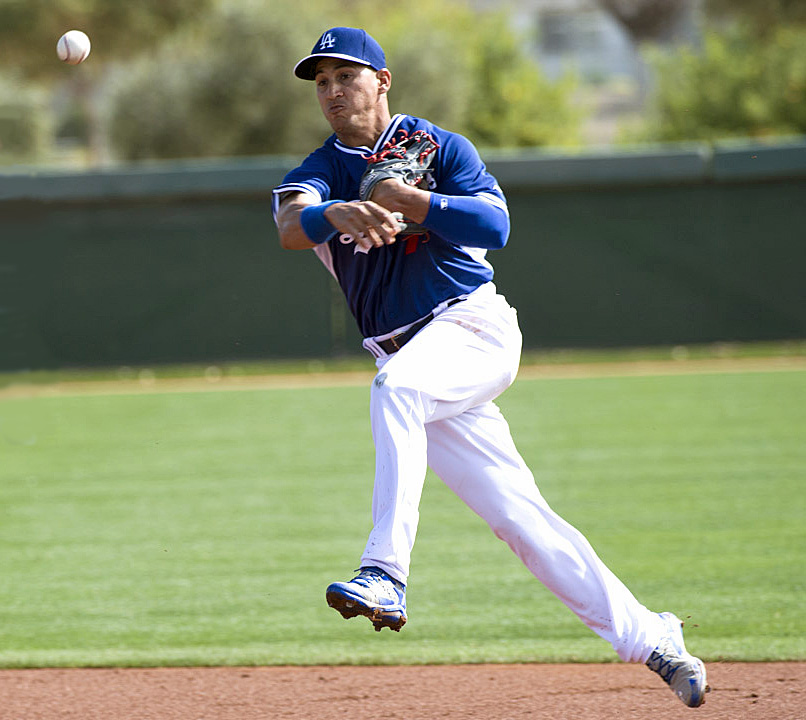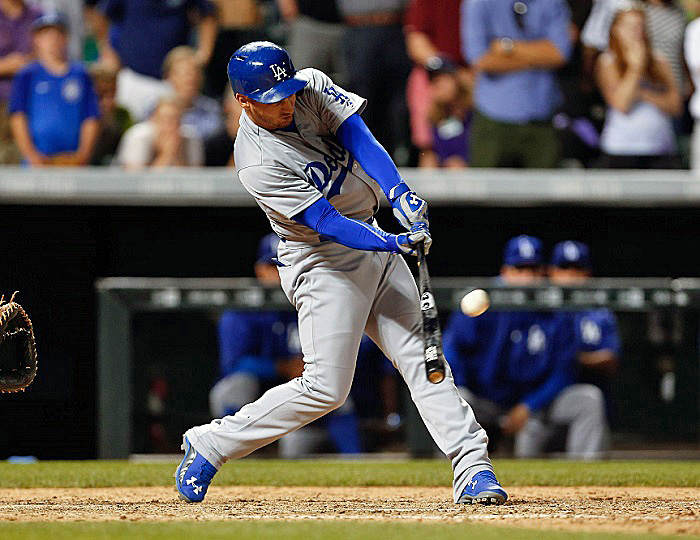When the Dodgers signed Alex Guerrero to a four-year / $28 million contract back on October 21, 2013, it seemed like a great idea at the time – especially with the extremely deep pockets of new Dodgers ownership and the Dodgers glaring need for a second baseman.
Guerrero, then a 26-year-old who had defected to Haiti in late 2013, was a natural shortstop and considered by many to be among the best players in Cuba before his defection. Although Guerrero was not considered a great defensive player, he was considered a very good hitter. In fact, while being showcased in front of scouts from several MLB teams in the Dominican Republic, Baseball America’s Ben Badler wrote this about Guerrero:
Guerrero’s best tool is his right-handed power … Guerrero takes an uppercut stroke and he loses his balance against breaking pitches. It’s a pull-oriented, swing-for-the-fences approach that scouts think he will have to change to hit quality pitching.
Since arriving in the Dominican Republic, Guerrero has shown improved speed with above-average times in the 60-yard dash, which is highly unusual for a 26-year-old to start running faster … [Some] scouts think he can stay in the middle of the infield, although shortstop is probably out of the question. His hands and actions are playable but he doesn’t have the first-step quickness or range to play shortstop and he can be a bit stiff in the field. Second base could be an option for him and a team that likes him a lot will probably play him there.
Despite having never played in the MLB (or in the MiLB for that matter), then Dodgers general manager Ned Colletti convinced Dodgers President and CEO Stan Kasten to roll the dice on Guerrero, signing him to a Scott Boras-crafted four-year / $28 million that included a $10 million signing bonus. As we’ve come to expect from Boras, considered by many to be baseball’s Antichrist, Guerrero’s contract included two rather unique clauses: the first said that Guerrero could not be optioned back to the minor leagues without his permission after 2014; and the second said that if Guerrero were traded, he would immediately become a free agent at the end of the season in which he was traded. (Did I mention that Scott Boras is considered by many to be baseball’s Antichrist?).

From Guerrero’s standpoint, his Scott Boras-crafted contract was brilliant. From the Dodgers standpoint, not so much. (Courtesy of BaseballProspectus.com)
Although Colletti nor anyone else in the Dodgers organization would admit it at the time, one of the main reasons they signed Guerrero was because of their glaring need at second base. They had recently declined to re-sign (then) 36-year-old veteran Mark Ellis primarily because they sincerely believed that Guerrero would become their everyday second baseman going forward. In fact, Colletti even said as much during a January 8, 2014 press conference at Dodger Stadium.
“We still have questions at second base,” said Colletti. “If you’re going to put who’s leading the pack today, Alexander is that player.”
During spring training 2014, Guerrero worked out almost exclusively at second base. It did not end well. Instead of becoming Mark Ellis’ heir apparent at second base, Guerrero struggled at the position and also at the plate, which landed him at Triple-A Albuquerque after the two season-opening games in Sydney, Australia. Fortunately for the Dodgers, converted shortstop Dee Gordon did do well at second base and went on to earn a trip to the 2014 All-Star game – an accomplishment that he would repeat in 2015 as a member of the Miami Marlins.

The Dodgers tried desperately to convert Guerrero from a shortstop into a second baseman during spring training 2014. The experiment failed miserably. (Photo credit – Jon SooHoo)
After a rather troublesome season at Triple-A during which he had a portion of his left ear bitten off by catcher Miguel Olivo, Guerrero received a September 1, 2014 call-up to the Dodgers. It, too, did not end well. In his 13 plate appearances, Guerrero had only one hit (a single) while striking out six times.
Knowing that Guerrero could not be sent back down to the minors, the now 28-year-old saw a considerable amount of playing time during spring training 2015 – primarily at third base and in left field. It did end well. So well, in fact, that the Dodgers were seriously considering making Guerrero their everyday third baseman except for one rather big reason – he was nowhere near as good of a defensive third baseman as 36-year-old Juan Uribe. However, Guerrero appeared to be living up to the hype of being a good hitter, going 15 for 49 (.304) with three home runs and eight RBIs in the 26 spring training games in which he played – 13 at third base, five in left field, four at shortstop and four as a DH / pinch-hitter.
With Scott Boras’ gun still to their head the Dodgers had no choice but to include Guerrero on their 2015 Opening Day roster which, for a while, appeared to be a great thing. In his first 22 at bats, Guerrero hit a remarkable five home runs including two as a pinch-hitter. But without question, his single greatest contribution to the team in 2015 was his dramatic top of the ninth inning grand slam on June 2 against the Colorado Rockies in the second game of a doubleheader at Coors Field. Guerrero’s slam turned an 8-5 deficit into a 9-8 Dodgers win to salvage a split in the twin bill.

Guerrero’s dramatic game-winning, pinch-hit grand slam home run against the Rockies on June 2 was arguably one of the greatest moment of the season for the Dodgers in 2015.
(Photo credit – Isaiah J. Downing – Click on photo to view video)
Unfortunately, Guerrero began a steady decline offensively after his heroic grand slam and finished the regular season with a slash-line of .233 / .261 / .434 for a rather pedestrian OPS of .695. He appeared in a total of 106 games with 230 plate appearances in which he hit 15 home runs and drove in 36 runs with 57 strikeouts and seven walks. All of a sudden that $28 million wasn’t such a great deal after all. In fact, Guerrero finished his first full regular season so poorly that he wasn’t included on the Dodgers postseason roster.
With new Dodgers manager Dave Roberts having now officially named Justin Turner as his everyday third baseman and with the likelihood that veterans Chase Utley and Howie Kendrick will fill in as needed as Turner’s backup, what do the Dodgers do with Alex Guerrero and the $10 million that they still owe him over the next two seasons? Keep in mind that both the “may not be optioned back to the minor leagues without his permission after 2014” and the “if traded, may become a free agent at season’s end” are still in play through the 2017 season.
Although the now 29-year-old Las Tunas, Cuba native will undoubtedly see considerable playing time this spring – both at third base and in the outfield – it’s probably safe to say that unless he comes out of the chute blazing hot and sets the world on fire this spring on both sides of the ball, spring training 2016 could very well be Guerrero’s last in a Dodger uniform.




 March 3rd, 2016 at 6:00 am
March 3rd, 2016 at 6:00 am  by Ron Cervenka
by Ron Cervenka  Posted in
Posted in 

I thought Dave Roberts was quoted that Guerrero would be used almost exclusively at third base? Even though Dodgers are reportedly “shopping” Guerrero there are some compelling reasons to keep him IF his 3b defense holds up in ST. Justin Turner health and eligible for free agency after this season, 32 in 2017 season, Utley will be gone, I have my doubts that Kendrick can play 3b other than in an emergency, zero well regarded 3b prospects in the high minors. and 2017 third base free agent class is extremely weak. Dodgers are loaded in the OF and it is possible that Micah Johnson could move to the OF as well. I think a good argument could be made to trade Scott Van Slyke (who will bring a greater return to the Dodgers) and keep Guerrero.
in re A Guerrero- you guys just know everything
By no means do I know everything, but I do have thoughts and opinions that I enjoy exchanging with other fans, particularly with fellow Dodgers fans
I saw enough to believe with proper instruction he could be an asset. He’s still in his prime years and he makes $5 million. All he needs to do is learn how to take certain pitches back through the box. Unless he’s an absolute cement head, which is possible, an effective hitting instructor could fix him. He’s already adequate at third base. I choose to believe his situation may be similar to Puig’s, in that a certain stubborn Indiana boy made his mind up before looking at ways to help the young hitter. I could be wrong about that. But I would ask you take a close look at Alex’s AAA numbers, before and after being cannibalized, and trust Roberts and Ward can get more out of him than Donnie and McGwiroid did.
SPOT ON!
Always liked what I saw in Guerrero and never could understand their reluctance to play him more…
Did he have disciplinary problems at OKC??? Something about playing at night??? p
Don’t know Pete. He seemed like a guy that kept to himself, but how would I know. My gut tells me the biggest problem he had was Mattingly. But again, I’m not an insider. I’m just a fan who believes Alex deserves a job somewhere. If not here, then work a deal elsewhere.
Well he certainly started off well in ST Game 1. I do believe that Roberts will work with Alex a lot different than Mattingly, and will get more out of him. Whether this will inspire the Dodgers to include him on the 25 man or move him in a trade to an AL team, we have three – four weeks to learn. I am not emotionally invested in Alex, so I want what works best for the Dodgers.